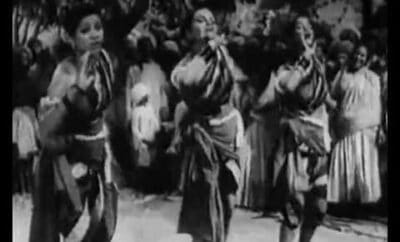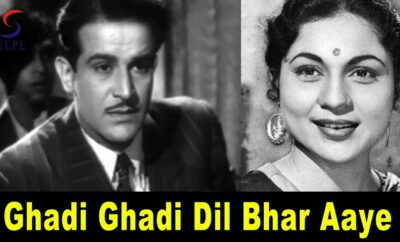Regional Scoop
When Lord Does The Work Of His Devotee – Kabirache Vinato Shele – Dev Pavla
Kabirache vinato shele, kausalecha Raam
Bhabadya ya bhaktasaathi, dev kari kaam
The actress (Sulochana) is a weaver and is seen weaving a cloth on the loom. Saint Kabir was a weaver and used to sing his ‘doha’ while doing his work, although completely engrossed in his prayers and songs. Here, the lady too is singing and praising Lord Ram while doing her work. She says that when Kabir worked on the loom and chanted the lord’s name, the lord came and did his devotee’s work thus completing his work. This philosophical wording shows that if we surrender ourselves to the almighty and do our work, god actually takes away all the hurdles and completes our work automatically.
Ek ekataari haati, bhakt gaayi geet
Ek ek dhaga jodi, jaanakicha naath
Raja ghanashyaam
With one ‘iktara’ in hand the devotee sings the lord’s name
While Janaki’s husband, Lord Ram, connects each small thread to weave the cloth
He, who has the beautiful dark skin, is the supreme king who is working for his worshipper
The music is given by P.L. Deshpande and the song is based on Raag Yaman. P.L. Deshpande is known for his work in literature especially comedy. But there was more to him when it came to talent. He was a writer, music director, humorist, singer and many more. This particular song is from the Marathi movie Dev Pavla (1950).
It feels like a bhajan because of the ‘taal’ of the song. It is well synchronized with that of the movement of the loom.
Daas Raamnaami range,Raam hoyi daas
Ek ek dhaga gunte, rup ye pattas
Raja ghanashyaam
Look at this beautiful sight!
While the slave (adorer) of lord Ram is absorbed in the lord’s name
Lord Ram has become his devotee’s slave and doing his work
He is weaving the threads of the cloth which is giving rise to the image of the chessboard on it
This dark-skinned god is the supreme king
These beautiful lyrics are written by G. D. Madgulkar. Each word carries such a deep meaning that one article will not be enough to explain it. The comparison of the song situation in the movie with that of Saint Kabir and Lord Ram is truly magical. He has woven this magical carpet of words for us to ponder over our life and life in general.
Vinun sarv zhaala shela, purn hoyi kaam
Thayi thayi shelyavarti, dise Raamnaam
Gupta hoyi Raam, Kausalyecha Raam baai Kausalyecha Raam
Raja ghanshyaam
Now the entire cloth has been weaved and the work is complete
And each little space on the cloth is full of lord Ram’s name
Such is the divine play that this king plays
The vocals by Manik Verma add to the divinity of this song. Each note of hers sounds like a prayer in itself. She is the goddess of music when it comes to classical songs. Her voice suits the heroine on screen Sulochana and it feels as if it is her own voice.
Halu halu ughadi dole, pahi to kabir
Vinuniya shela gela, sakha raghuveer
Kuthe mhane Raam?
The devotee, Kabir, now slowly opens his eyes
And sees that the lord completed the weaved the entire shawl
But now he is nowhere to be seen
Where did He go?
When we devote ourselves completely to this divine power, we become one with it. Then there remain no two entities. Here, the poet has tried to explain the same thing. When the entire work was done by the lord, on completion, he went away. The devotee, now confused, is unable to understand as to who did it? Where did the lord go? He was always within him, in his heart and in his soul.
So surrender to the Divine and Lord do His work.




Snehal Purandare
October 15, 2020 at 7:07 am
apratim spashtikaran !
Aditya patwardhan
January 10, 2021 at 12:21 pm
Nice Explanation. Thanks a lot
Sharayu Ghodekar
April 23, 2021 at 3:26 pm
You have beautifully explained. Thank you for sharing!